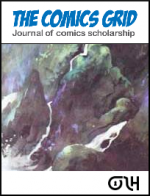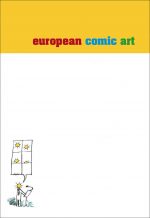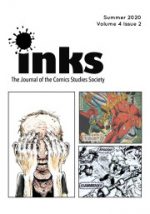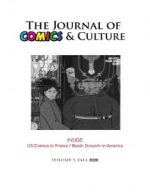The Journal Monitor is a subcategory of the regular Monitor. It is an irregularly published overview of issues of international journals on comics studies as well as special issues on corresponding topics. The introductory texts and/or tables of contents come from the respective websites.
Do you have suggestions or information on new releases that have been overlooked and should be introduced on our website? Please let us know via email: redaktion@comicgesellschaft.de.
→ See previous Monitor posts.
 The Comics Grid 10
The Comics Grid 10
online (open access)
Website
- Candida Rifkind: The Elements of a Life: Lauren Redniss’s Graphic Biography of Marie Curie
- Susan Bond: “It’s Showtime, Synergy!”: Musical Sequences in Jem and the Holograms
- Miranda Corcoran: Bleeding Panels, Leaking Forms: Reading the Abject in Emily Carroll’s Through the Woods (2014)
- Mark Anthony Giancaspro: Picture-Perfect or Potentially Perilous? Assessing the Validity of ‘Comic Contracts’
- Aislinn O’Connell: Generic Super Heroes: Can They Exist?
- Christian Mehrstam: Silver Lining: The Emblematic Exemplum of Silver Surfer #40–43 (1990)
- Harriet Earle: The Politics of Lace in Kate Evans’ Threads: From the Refugee Crisis (2017)
- Jamie Michaels: Graphic Backgrounds: Collective Dissociative Trauma in Rutu Modan’s Exit Wounds (2007)
 European Comic Art 13.2
European Comic Art 13.2
online (via subscription)
Website
- Laurence Grove, Anne Magnussen, Ann Miller: Introduction: Mise en abyme
- Renaud Chavanne: The Bunker and the Desert: On the Motif of the Cube-panel in Inside Mœbius
- Thierry Groensteen: Five Years of Editing Les Cahiers de la Bande Dessinée
- Francisca Lladó: El Perdón y la furia and José de Ribera’s Journey from Faith to Magic: Historical Fiction by Altarriba and Keko
- Fredrik Strömberg: Schemata in the Graphic Novel Persepolis: Accommodation, Combination, Integration
 inks: The Journal of the Comics Studies Society 4.2
inks: The Journal of the Comics Studies Society 4.2
online (via subscription)
Website
- Eli Boonin-Vail: “The Body of the Nation”: Ta-Nehisi Coates’ Black Panther and the Black Literary Tradition
- Madeline B. Gangnes, Kevin Cooley: Drawn to Reconcile: The Queer Reparative Journey of ElfQuest
- Sam Cowling: Rethinking Racial Ontology through McDuffie’s Deathlok
- Frederik Byrn Køhlert: “A Grotesque, Incurable Disease”: Whiteness as Illness in Gabby Schulz’s Sick
- Maaheen Ahmed: From the Archives: The Alain Van Passen Collection: At the Crossroads of Comics Collecting and Critique
 Journal of Graphic Novels and Comics
Journal of Graphic Novels and Comics
online (open access)
Website
- Michelle Ann Abate: Ziggy was here: Tom Wilson’s newspaper comic, World War II, and the role of graffiti in sequential art
- Namrata Dey Roy, Mary Helen O’Connor: Rolling Blackouts: voicing the other micro-narratives
- Subir Dey, Prasad Bokil: The narrative functions of sound-symbolic words in comics and graphic novels
- Li-Chi Chen, Eryk Hajndrych: Comicbook characters’ facial features and actions and movements as two sources of humour: the case of Fullmetal Alchemist
- Bancha Rattanamathuwong: Queering the harem: queerness in reverse harem manga and anime
- Purba Chakraborty, Rashmi Gaur: Hermeneutic flashbacks: building the narrative space in Joe Sacco’s Safe Area Goražde
- A.J. Paylor: Comics and the Situationist International
- Katharina Wiedlack: Ballerina with PTSD: imagining Russia in contemporary Black Widow comics
- Franco Vitella: Comics, the library has those: how public libraries can use graphic novels to foster reading communities
- Suhaan Kiran Mehta: Colouring superheroes: Hue, saturation, and value in Ms.Marvel: Kamala Khan #1 and DC’s Detective Comics Annual #12 and Batman Annual #28
- Andy Draycott: Iconoclasm, iconophobia, and graphic novel adaptations of John Bunyan’s The Pilgrim’s Progress
- Nicoletta Mandolini: Let’s go graphic. Mapping Italian graphic novels on gender-based violence
- Sathyaraj Venkatesan, Sweetha Saji: Capturing alternate realities: visual metaphors and patient perspectives in graphic narratives on mental illness
- Abhilasha Gusain, Smita Jha: Trauma, Memory, History and its Counter Narration in Thi Bui’s Graphic Memoir The Best We Could Do
- Nicholas Holm: Excalibur, aesthetics and an other Britain: from whimsical tradition to tabloid aesthetic
- Santiago Parga Linares: Proustian curiosity and the archive: Alison Bechdel’s Fun Home
- Phillip Joy, Stéphanie E. M. Gauvin, Megan Aston, Matthew Numer: Reflections in comics: the views of queer artists in producing body image comics and how their work can improve health
- Ewa Stańczyk: Szaber in post-war Poland: satirising plunder in Polish magazine cartoons (1945-1946)
C omics and Culture 5*
omics and Culture 5*
print (via subscription)
Website
- Paul Levitz: French Comics in America
- Jean-Paul Gabilliet: US Comics in France: A Brief Historical Survey
- Paul Gravett: “Yeah, Well, They Love Jerry Lewis, Don’t They?”: The French Connections That Helped Bring BD to the USA
- Sylvain Lesage: Angoulême and the Ninth Art: From Comics Fandom to Cultural Policies
- Pascal Ory: Mickey Go Home! The De-Americanization of Bande Dessinée (1945-1950)
- Nicolas Labarre: “The Illustrated Fantasy Magazine from France.” From Métal Hurlant to Heavy Metal
- Benoît Crucifix, Sylvain Lesage: (À Suivre) Overseas: The Transatlantic Circulation of the French Graphic Novel
*The ComFor editorial board regrets the lack of diversity in this publication. We endeavour to cover the entire spectrum of comics studies, report in a neutral way and keep the editorial selection process to a minimum. But we are also aware of the problematic structures that shape our academic research environment and that frequently lead to a lower visibility of female comics scholars as well as those with marginalised identities in general. We know that this imbalance is often not intended by the editors / organisers and we do not want to imply this in any way. But nonetheless, we would like to draw attention to it to raise awareness for this problem.